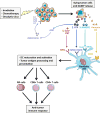Damage-associated molecular patterns in cancer: a double-edged sword
- PMID: 27086930
- PMCID: PMC5119456
- DOI: 10.1038/onc.2016.104
Damage-associated molecular patterns in cancer: a double-edged sword
Abstract
Damage-associated molecular patterns (DAMPs) are released in response to cell death and stress, and are potent triggers of sterile inflammation. Recent evidence suggests that DAMPs may also have a key role in the development of cancer, as well as in the host response to cytotoxic anti-tumor therapy. As such, DAMPs may exert protective functions by alerting the immune system to the presence of dying tumor cells, thereby triggering immunogenic tumor cell death. On the other hand, cell death and release of DAMPs may also trigger chronic inflammation and, thereby promote the development or progression of tumors. Here, we will review the contribution of candidate DAMPs and their receptors, and discuss the evidence for DAMPs as tumor-promoting and anti-tumor effectors, as well as unsolved questions such as DAMP release from non-tumor cells as well as the existence of tumor-specific DAMPs.
Figures


References
-
- Dvorak HF. Tumors: Wounds That Do Not Heal. Similarities between Tumor Stroma Generation and Wound Healing. N Engl J Med. 1986;315:1650–1659. - PubMed
-
- Dolberg DS, Hollingsworth R, Hertle M, Bissell MJ. Wounding and Its Role in Rsv-Mediated Tumor Formation. Science. 1985;230:676–678. - PubMed
-
- Hockel M, Dornhofer N. The Hydra Phenomenon of Cancer: Why Tumors Recur Locally after Microscopically Complete Resection. Cancer Res. 2005;65:2997–3002. - PubMed
-
- Kaczmarek A, Vandenabeele P, Krysko DV. Necroptosis: The Release of Damage-Associated Molecular Patterns and Its Physiological Relevance. Immunity. 2013;38:209–223. - PubMed
-
- Obeid M, Tesniere A, Ghiringhelli F, Fimia GM, Apetoh L, Perfettini JL, et al. Calreticulin Exposure Dictates the Immunogenicity of Cancer Cell Death. Nat Med. 2007;13:54–61. - PubMed
Publication types
MeSH terms
Substances
Grants and funding
LinkOut - more resources
Full Text Sources
Other Literature Sources
Research Materials

